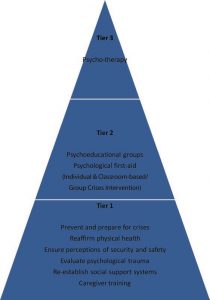This domain pertains to a school psychologists knowledge related to resiliency and risk factors in relation to learning and mental health. Prevention is an important component of the effective interventions that school psychologists engage in to support children. A school psychologist will use their knowledge of risk and protective factors to address problems such as school completion, truancy, bullying, youth suicide, and school violence. School psychologists will develop programs that address precursors to severe learning and behavioral problems and participate in school crisis prevention and response teams.

EDPS 602 – Counselling Theories and Professional Practice
EDPS 676 – Practicum in Social, Emotional and Behavioural Assessment and Intervention
Bor, W., Dean. A., Najman, J., & Hayatbak, R. (2014) Are child and adolescent mental health problems increasing in the 21st century? A systematic review. Australian and New Zealand Journal of Psychiatry, 48(7), 606-616. doi: 10.1177/0004867414533834
Summary
This literature review study was conducted due to the hight rate of mental illness reported among children and adolescence. Research indicates that up to one in five children world-wide experience mental health problems. Their findings suggest an increase in internalizing problems in adolescent girls.
How Article has Informed Practice
It is important to apply evidence-based research to back up claims such as “instances of mental health in children are on the rise.” This study reports that the increase in mental health conditions is only documented for the population of adolescent girls. With this information, it is important to explore approaches for early intervention and prevention for the adolescent female population as this finding has a number of public health implications. The association between symptom reports in adolescents and adverse outcomes reinforces the importance of prevention, identification, and treatment programmes. Moving forward, an area for further development and growth could be working with this demographic in terms of social skills and resiliency training.
Reference
Fazel, M., Hoagwood, K.,Stephan,S., & Ford,t. (2014) Mental health interventions in schools 1: Mental health interventions in schools in high-income countries. Lancet Psychiatry. 1(5): 377–387. doi:10.1016/S2215-0366(14)70312-8.
Summary
The focus of this article by fazel and colleagues is around the notion that mental health services should be embedded within school systems to create integrative care that improves both mental health and educational attainment for children. The authors argue for a reconfiguration of educational systems in order for evidence based practices to be implemented. The researchers outline the ethical and scientific justifications for integration of mental health and education which can promote the healthy development of children.
How Article has Informed Practice
I think that this is a very strong and well written article because it is not only suggesting an intervention, it is also suggesting that the educational framework needs to be changed in order to make that change. I identified with this because as an educator, it becomes exhausting to have strategies and suggestions thrown at you, without any support in rearranging the system in order to make the intervention successful. I think that integrating interventions such as the mind up program is one place to start, however there are many other more targeted mental health interventions that could serve as preventative methods.
Reference
Twenge, J. (2011). Generational Differences in Mental Health: Are Children and Adolescents Suffering More, or Less? American Journal of Orthopsychiatry, 81(4) 469–472. doi: 10.1111/j.1939-0025.2011.01115.x
Summary
Almost all of the available evidence suggests a sharp rise in anxiety, depression, and men- tal health issues among Western youth between the early 20th century and the early 1990s. Between the early 1990s and the present, more serious problems such as suicide and depression have receded in some data sets, whereas feeling overwhelmed and report- ing psychosomatic complaints have continued to increase. Other indicators, such as anxi- ety, have remained at historically high levels but not continued to increase. This mixed pattern of results may be rooted in the increasing use of antidepressants and therapy and the improvement in some cultural indicators. However, the incidence of youth mental health problems remains unacceptably high.
How Article has Informed Practice
It is important to be informed of the biases and trends in mental health diagnosis. The trend towards diagnosing ADHD and now the trend towards Anxiety Disorder all influence the assessment process. Parents may come in for an assessment with a knowledge of a disorder that they are getting from pop culture, rather than evidence-based. This pressure to fulfill their suspected diagnosis can lead to biases in the decision making process. It is important to be aware of this when moving forward with my professional practice.